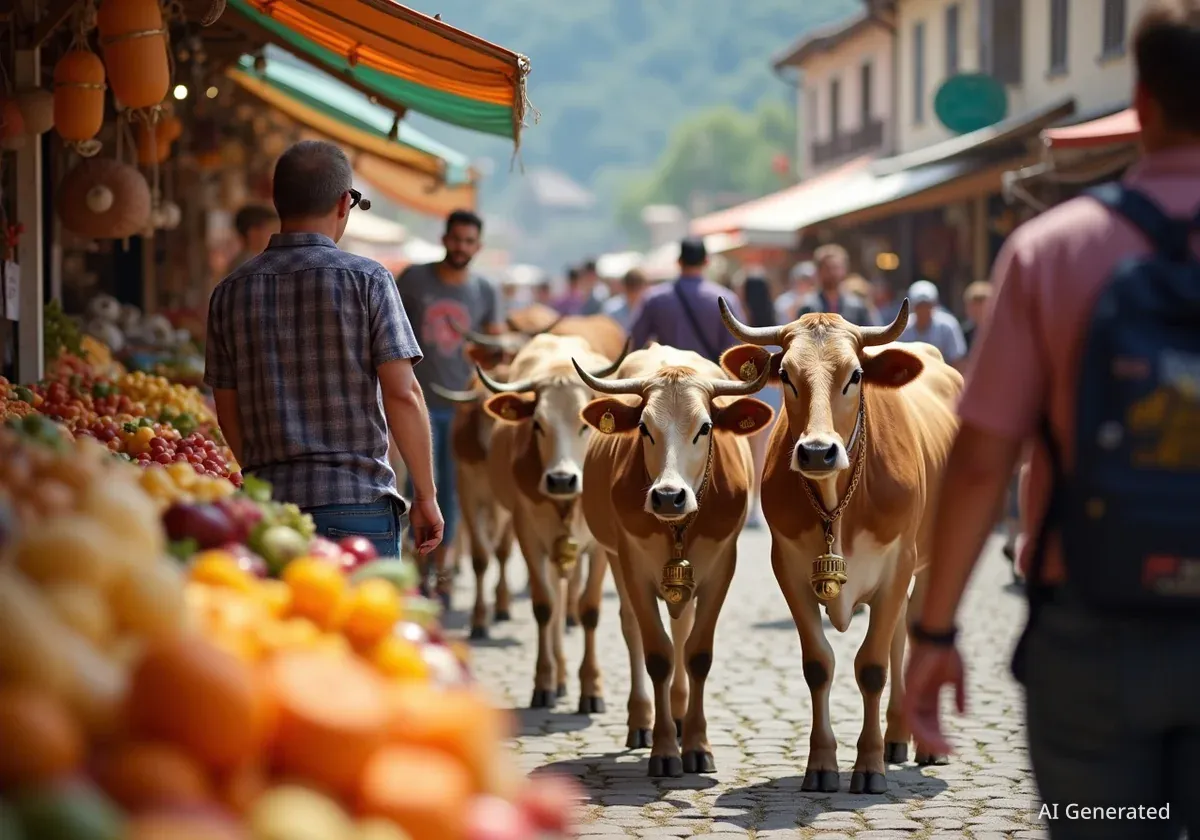Bern's Bundesplatz recently hosted the annual Sichlete harvest festival, a traditional event that brings agricultural life directly into the heart of the Swiss capital. This year marked the 20th anniversary of the festival under the organization of the Bernese Farmers' Association (BBV), offering city residents a direct connection with rural traditions and local producers.
Key Takeaways
- The Sichlete festival transforms Bern's Bundesplatz into a market each autumn.
- It celebrates harvest traditions and connects urban and rural populations.
- A key highlight is the ceremonial procession of cows onto the square.
- This year's special theme focused on promoting regional cabbage and carrots.
- The event emphasizes the importance of local food production and consumption.
A Tradition on Bundesplatz
The Sichlete festival is a long-standing tradition. It takes place once a year, during the autumn parliamentary session. The Bernese Farmers' Association organizes this harvest thanksgiving event. Claudia Bernhard, who manages central operations for the BBV, emphasized its traditional nature. She has been planning the event for 20 years. During this time, some aspects have changed.
City regulations have become stricter. The number of market stalls has also decreased. It once had 30 stalls. Now, only about 11 remain. Despite these changes, the core spirit of the festival endures. It continues to be a vital link between farmers and city dwellers.
Sichlete Facts
- Duration: Annually, during the autumn parliamentary session.
- Organizer: Bernese Farmers' Association (BBV).
- Purpose: Traditional harvest festival and market.
- Stall Count: Reduced from 30 to approximately 11 over 20 years.
The Cow Procession: A Festival Highlight
One of the most anticipated moments at Sichlete is the ceremonial procession of cows. This event, known as the Alpauf- and -abfahrt, sees cows moving through city streets to Bundesplatz. Claudia Bernhard described this as "really amazing." She finds it remarkable that such an event can happen in the city center, right in front of the Parliament building, during a session.
"Many tourists can hardly believe that such an event can be held in front of the Parliament building," Bernhard added, laughing.
This unique spectacle draws large crowds. It offers a rare chance for city residents and tourists to see farm animals up close. The cows for this procession belong to the Schweizer family from Utzigen. Farmer Markus Schweizer stated, "We are participating for the sixth time." For him, taking part in Sichlete is "one of the most beautiful days in autumn."
The Schweizer Family's Contribution
Markus Schweizer's dairy farm is substantial. It covers 25 hectares of land. The farm has 30 animals. Most of these animals are of the Swiss Fleckvieh breed. Bringing twelve of their cows to Bundesplatz is a significant effort. It highlights the dedication of farming families to this traditional festival. Their participation helps bridge the gap between agricultural practices and urban understanding.
Bridging Urban and Rural Life
The Sichlete festival serves a crucial role in modern Switzerland. It creates a direct dialogue between farmers and city residents. In an increasingly fast-paced world, this connection is vital. It helps urban populations understand where their food comes from. It also highlights the hard work involved in food production.
Promoting Local Products and Appreciation
Producers from across the canton of Bern bring their animals, products, and customs to the city. This direct exchange is important, especially in current times. Jürg Iseli, President of the Bernese Farmers' Association (BBV), emphasized this point. He noted that in a "time that could not be more hectic" and where "food security can be affected," it is important for farmers to be present.
"We show people what we have produced throughout the year. We also say thank you for consuming our regional products," Claudia Bernhard stated, explaining the event's purpose.
The festival acts as a marketplace. Visitors can buy fresh, regional produce directly from the farmers. This supports local agriculture. It also encourages sustainable consumption habits. The farmers get a chance to connect with their customers. They receive direct feedback and appreciation for their work.
"Chabis & Rüebli": This Year's Special Theme
Each year, Sichlete features a special theme. This year, the focus was on "Chabis & Rüebli," which translates to cabbage and carrots. This theme aimed to promote regional and seasonal shopping. It encouraged people to buy these products, whether at the market or in stores. Katja Riem, President of the Bern-Fribourg Vegetable Producers' Association (GVBF), highlighted the importance of informed choices.
"Everyone should find out what they are buying," Riem advised.
Activities related to the theme engaged visitors. Children and adults enjoyed "carrot fishing," where they could win real carrots. There was also an opportunity to shred cabbage. This shredded cabbage would then be processed into sauerkraut. These interactive elements made learning about local produce fun and engaging. They reinforced the message of supporting local farmers and eating seasonally.
Educational and Engaging Activities
- Carrot Fishing: A game where participants fish for wooden carrots to win real ones.
- Cabbage Shredding: Visitors could participate in shredding cabbage, learning about sauerkraut production.
- Product Demonstrations: Farmers showcased their produce and explained their farming methods.
The special theme effectively communicated the value of regional vegetables. It showed how simple, local ingredients can be used in traditional ways. This helps consumers make healthier and more sustainable food choices. The festival continues to be a cornerstone event for Bern, celebrating agriculture and community.
The Sichlete festival remains a vital platform. It connects city residents with the source of their food. It also preserves important agricultural traditions. As urban areas grow, these events become even more crucial. They remind everyone of the hard work involved in farming. They also highlight the value of local, seasonal produce.



